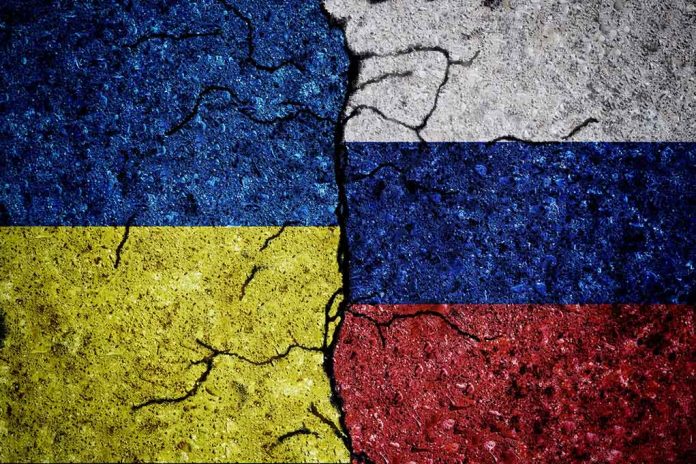
Russia launched its largest aerial assault on Ukraine since the war began, with a record 355 drones and missiles targeting multiple regions, resulting in at least 12 civilian deaths as peace talks hang in the balance.
Key Takeaways
- Russia accuses Ukraine of deliberately escalating air attacks to derail peace negotiations, citing 2,331 Ukrainian drones allegedly destroyed between May 20-27
- Ukraine experienced its largest air attack since the 2022 invasion, with Russia launching 355 drones and 9 cruise missiles across multiple regions
- President Trump has criticized Putin’s actions and threatened additional sanctions while diplomatic efforts have increased with direct talks between Russian and Ukrainian officials
- Russia has rejected a proposed 30-day unconditional ceasefire while demanding Ukraine abandon NATO ambitions and cede territory
- Both nations recently conducted their largest prisoner exchange to date, swapping 1,000 people each despite escalating military actions
Moscow Claims Ukraine Undermining Peace Process
The Kremlin has accused Ukraine of deliberately sabotaging peace negotiations through increased aerial attacks. Russian officials maintain that Kyiv, potentially with European support, is taking deliberate actions to disrupt diplomatic initiatives. The allegations come amid what appears to be contradictory behavior from Moscow, which has simultaneously escalated its own aerial campaign against Ukraine while professing interest in peace talks. This latest round of accusations highlights the complex psychological and propaganda elements that continue to shape the conflict.
“Kyiv, with the support of some European countries, has taken a series of provocative steps to thwart negotiations initiated by Russia,” said the Russian defence ministry.
Kremlin spokesman Dmitry Peskov reinforced this position, stating: “At the very least, we can say that these actions by Kyiv are inconsistent with efforts towards a peace process.” The Russian defense ministry claims its forces intercepted and destroyed 2,331 Ukrainian drones over an eight-day period between May 20-27, portraying these alleged attacks as deliberate provocations designed to undermine Russia’s supposed peace overtures. Moscow continues to frame its massive aerial assault as a justified response to Ukrainian aggression.
Ukraine-Russia war: Warning over Trump’s failed peace talk plan after Putin launches largest drone strikehttps://t.co/AlsrOB9X7p
— The Independent (@Independent) May 26, 2025
Record-Breaking Aerial Assault Devastates Ukrainian Cities
Russia’s recent aerial attack on Ukraine represents the largest since the full-scale invasion began in February 2022. The bombardment included a record 355 drones and nine cruise missiles targeting multiple regions, including the capital Kyiv. The assault caused significant civilian casualties, with at least 12 deaths reported and dozens more injured. Ukrainian officials report widespread damage to civilian infrastructure, including hospitals, residential buildings, and energy facilities, contradicting Russia’s claims that it only targets military objectives.
“The last three nights were absolutely sleepless. One of the nights I spent in the metro station sheltering from the Russian ballistic missiles. The other two, I slept at home but I was regularly woken up by the explosions. They were very loud and of course it was very chilling,” said Olena Halushka, Ukrainian activist.
The timing of this massive attack amid supposed peace talks has raised questions about Russia’s sincerity in diplomatic efforts. Ukrainian citizens have endured continuous bombardment while the Kremlin simultaneously accuses Ukraine of escalation. The pattern of increasing attacks while claiming to pursue peace has become a familiar tactic in Russia’s approach to the conflict, creating an environment where diplomatic progress seems increasingly difficult to achieve.
Trump Administration Takes Stronger Stance Against Putin
President Trump has taken a more assertive position against Russian aggression, criticizing Putin’s actions and threatening additional sanctions. This stance represents a significant development in the administration’s approach to the conflict. According to reports, Trump expressed concern that Putin’s continued military actions could lead to Russia’s downfall, signaling a potentially tougher U.S. position on the conflict. The administration appears to be balancing diplomatic engagement with increased pressure on Moscow.
“We would, of course, hope very much. We would very much hope that President Trump would finally see the real nature of Putin and finally start implementing his own principle — peace through strength. But this strength should be pressure over the aggressor, not pressure over the victim,” said Olena Halushka, Ukrainian activist.
The White House has been actively involved in facilitating peace talks, with direct negotiations between Russian and Ukrainian officials occurring for the first time in three years. However, these diplomatic efforts have been complicated by Russia’s refusal to accept a proposed 30-day unconditional ceasefire. Instead, Moscow is reportedly preparing a document outlining its peace terms, which is expected to demand Ukraine abandon its NATO ambitions and surrender significant territory – conditions that Ukraine has consistently rejected as unacceptable.
Competing Narratives Shape International Response
The information war surrounding the conflict continues to influence global responses. Russian officials consistently frame their actions as defensive responses to Ukrainian provocations, while Ukraine and its allies present evidence of deliberate Russian targeting of civilian infrastructure. This battle over narrative has real consequences for international policy, with Ukrainian officials calling for increased sanctions and military aid while facing what they describe as hesitation from some Western partners.
“I think it’s very important that our partners do not actually care or seriously treat what Russia is saying because Russians are lying. They are just inventing disinformation, they are inventing new reality and they are trying to sell this new reality to our partners,” said Olena Halushka, Ukrainian activist.
Despite the escalating violence, some diplomatic progress has occurred, with both nations recently conducting their largest prisoner exchange to date, swapping 1,000 people each. This exchange represents a rare point of cooperation amid deteriorating relations. Meanwhile, Ukrainian President Volodymyr Zelenskyy’s chief of staff, Andriy Yermak, has emphasized the need for increased pressure on Russia, stating: “We need to end this eternal waiting — Russia needs more sanctions.” The competing diplomatic and military pressures highlight the multifaceted nature of a conflict that continues to defy simple solutions.













